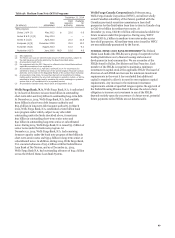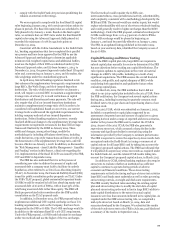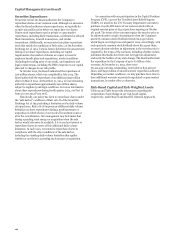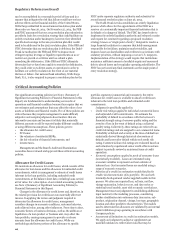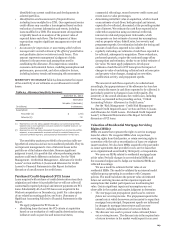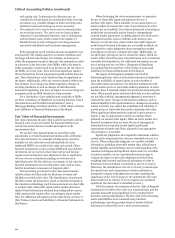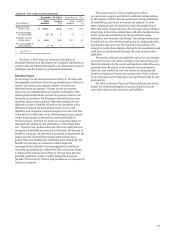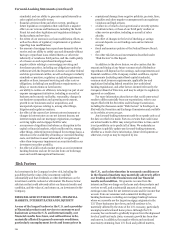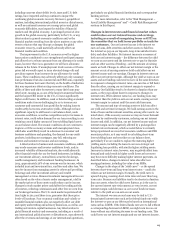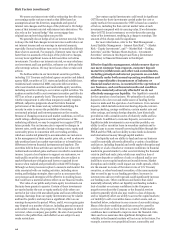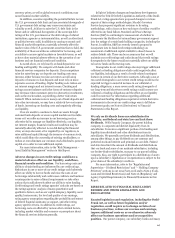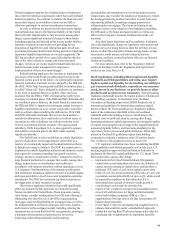Wells Fargo 2014 Annual Report Download - page 111
Download and view the complete annual report
Please find page 111 of the 2014 Wells Fargo annual report below. You can navigate through the pages in the report by either clicking on the pages listed below, or by using the keyword search tool below to find specific information within the annual report.
identified from current conditions and developments in
selected portfolios.
• Identification and measurement of impaired loans,
including loans modified in a TDR. Our experienced senior
credit officers may consider a loan impaired based on their
evaluation of current information and events, including
loans modified in a TDR. The measurement of impairment
is typically based on an analysis of the present value of
expected future cash flows. The development of these
expectations requires significant management review and
judgment.
• An amount for imprecision or uncertainty which reflects
management’s overall estimate of the effect of quantitative
and qualitative factors on inherent credit losses. This
amount represents management’s judgment of risks
inherent in the processes and assumptions used in
establishing the allowance. This imprecision considers
economic environmental factors, modeling assumptions and
performance, process risk, and other subjective factors,
including industry trends and emerging risk assessments.
SENSITIVITY TO CHANGES Table 64 demonstrates the impact
of the sensitivity of our estimates on our allowance for credit
losses.
Table 64: Allowance Sensitivity Summary
December 31, 2014
Estimated
increase / (decrease)
(in billions) in allowance
Assumption:
Favorable (1) $ (2.5)
Adverse (2) 7.8
(1) Represents a one risk rating upgrade throughout our commercial portfolio
segment and a more optimistic economic outlook for modeled losses on our
consumer portfolio segment.
(2) Represents a one risk rating downgrade throughout our commercial portfolio
segment, a more pessimistic economic outlook for modeled losses on our
consumer portfolio segment, and incremental deterioration for PCI loans.
The sensitivity analyses provided in the previous table are
hypothetical scenarios and are not considered probable. They do
not represent management’s view of inherent losses in the
portfolio as of the balance sheet date. Because significant
judgment is used, it is possible that others performing similar
analyses could reach different conclusions. See the “Risk
Management - Credit Risk Management - Allowance for Credit
Losses” section and Note 6 (Loans and Allowance for Credit
Losses) to Financial Statements in this Report for further
discussion of our allowance for credit losses.
Purchased Credit-Impaired (PCI) Loans
Loans acquired with evidence of credit deterioration since their
origination and where it is probable that we will not collect all
contractually required principal and interest payments are PCI
loans. Substantially all of our PCI loans were acquired in the
Wachovia acquisition on December 31, 2008. For a description
of our related accounting policies, see Note 1 (Summary of
Significant Accounting Policies) to Financial Statements in this
Report.
We apply judgment for PCI loans in:
• identifying loans that meet the PCI criteria at acquisition
based on our evaluation of credit quality deterioration using
indicators such as past due and nonaccrual status,
commercial risk ratings, recent borrower credit scores and
recent loan-to-value percentages.
• determining initial fair value at acquisition, which is based
on an estimate of cash flows, both principal and interest,
expected to be collected, discounted at the prevailing market
rate of interest. We estimate the cash flows expected to be
collected at acquisition using our internal credit risk,
interest rate risk and prepayment risk models, which
incorporate our best estimate of current key assumptions,
such as property values, default rates, loss severity and
prepayment speeds. Our estimation includes the timing and
amount of cash flows expected to be collected.
• regularly evaluating our estimates of cash flows expected to
be collected, subsequent to acquisition. These evaluations,
performed quarterly, require the continued usage of key
assumptions and estimates, similar to our initial estimate of
fair value. We must apply judgment to develop our
estimates of cash flows for PCI loans given the impact of
changes in value of underlying collateral such as home price
and property value changes, changing loss severities,
modification activity, and prepayment speeds.
The amount of cash flows expected to be collected and,
accordingly, the appropriateness of the allowance for loan loss
due to certain decreases in cash flows expected to be collected, is
particularly sensitive to changes in loan credit quality. The
sensitivity of the overall allowance for credit losses, including
PCI loans, is presented in the preceding section, “Critical
Accounting Policies - Allowance for Credit Losses.”
See the “Risk Management - Credit Risk Management -
Purchased Credit Impaired Loans” section and Note 6 (Loans
and Allowance for Credit Losses - Purchased Credit Impaired
Loans") to Financial Statements in this Report for further
discussion of PCI loans.
Valuation of Residential Mortgage Servicing
Rights (MSRs)
MSRs are assets that represent the rights to service mortgage
loans for others. We recognize MSRs when we purchase
servicing rights from third parties, or retain servicing rights in
connection with the sale or securitization of loans we originate
(asset transfers). We also have MSRs acquired in the past under
co-issuer agreements that provide for us to service loans that
were originated and securitized by third-party correspondents.
We carry our MSRs related to residential mortgage loans
at fair value. Periodic changes in our residential MSRs and
the economic hedges used to hedge our residential MSRs are
reflected in earnings.
We use a model to estimate the fair value of our
residential MSRs. The model is validated by an internal model
validation group operating in accordance with Company
policies. The model calculates the present value of estimated
future net servicing income and incorporates inputs and
assumptions that market participants use in estimating fair
value. Certain significant inputs and assumptions are not
observable in the market and require judgment to determine:
• The mortgage loan prepayment speed used to estimate
future net servicing income. The prepayment speed is the
annual rate at which borrowers are forecasted to repay their
mortgage loan principal. Prepayment speeds are influenced
by changes in mortgage interest rates and borrower
behavior, including estimates for borrower default.
• The discount rate used to present value estimated future
net servicing income. The discount rate is the required rate
of return investors in the market would expect for an asset
109


